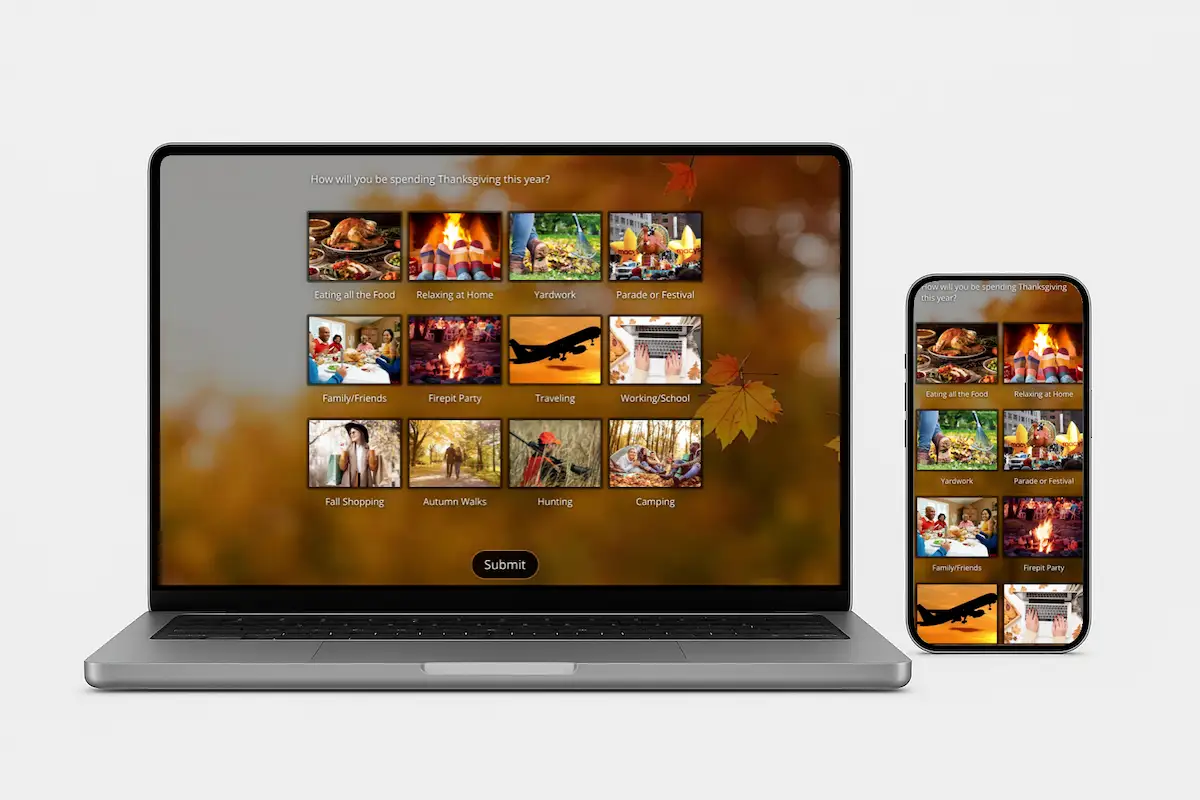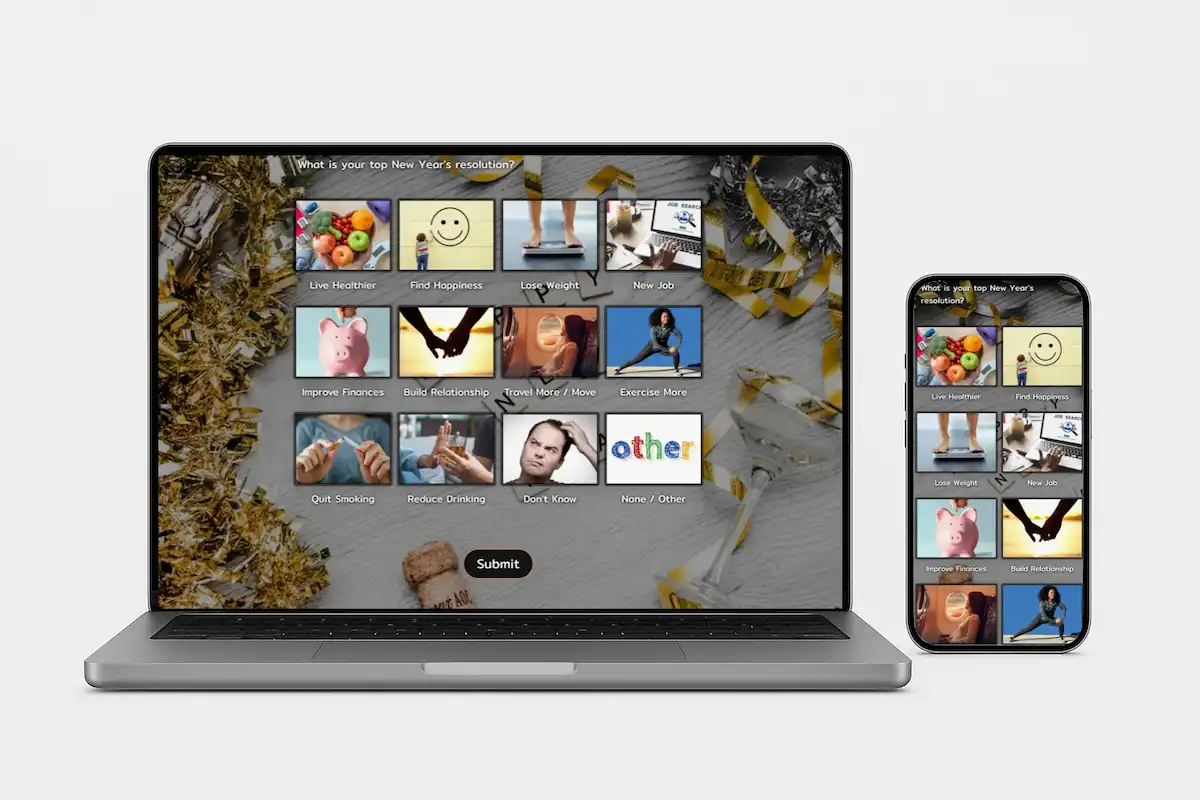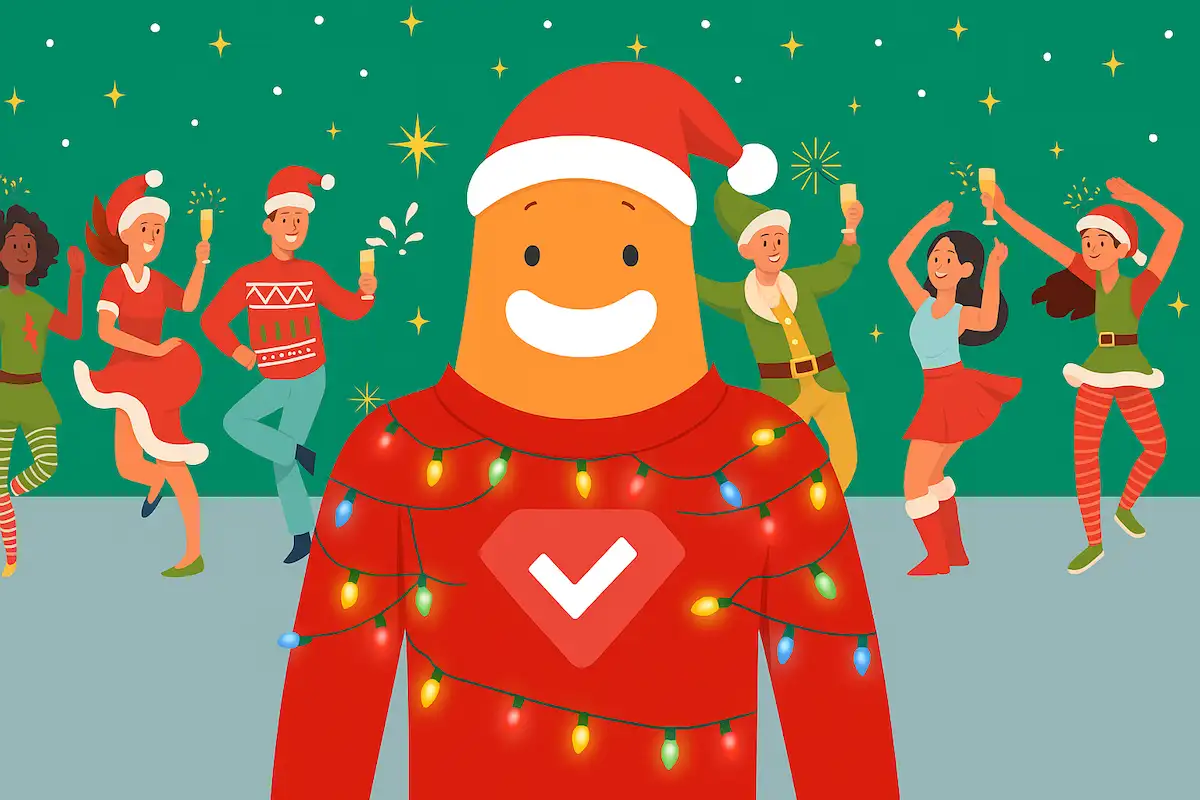A Thanksgiving survey, contest, or quiz is a fun and engaging way to celebrate the holiday, gather opinions, or test knowledge about Thanksgiving traditions. The blog covers the history of Thanksgiving, from the 1621 feast to modern Friendsgiving, and explains how surveys can highlight favorite foods, activities, and traditions. It explores popular Thanksgiving survey types, including activity polls, restaurant feedback surveys, and school or church trivia quizzes. The article also offers ideas for Thanksgiving contests, quizzes, team-building activities, and tips for hosting successful events. Using SurveyLegend, you can easily create image-based surveys to boost engagement and capture valuable insights during the holiday season.
Create your FREE Thanksgiving survey, poll, or questionnaire now!
History of Thanksgiving
Thanksgiving has a long history in the United States, where it is celebrated on the fourth Thursday of November each year (some other countries also observe a similar holiday; see our FAQs for more information). Here’s a timeline of significant events surrounding this mostly American holiday.
-
1621. The Plymouth colonists from England and the Native American Wampanoag people share an autumn harvest feast, marking the first Thanksgiving celebration. Foods served at the first Thanksgiving included venison, corn, and possibly fish, but not ham. Pumpkins were also a traditional food, though not in pie form.
-
1789. President George Washington issued the first Thanksgiving proclamation, calling upon Americans to express their gratitude for the happy conclusion to the country’s war of independence and ratification of the U.S. Constitution.
-
1817. New York becomes the first of several states to officially adopt an annual Thanksgiving holiday.
-
1863. President Abraham Lincoln, in the midst of the Civil War, made Thanksgiving a national holiday to be held each November, as an expression of gratitude for a pivotal Union Army victory at Gettysburg.
-
1924. New York City’s Macy’s Thanksgiving Day parade begins, becoming the largest and most famous American parade and attracting around three million spectators along its 2.5-mile route.
-
1947. President Harry Truman officially pardons the first National Thanksgiving Turkey, though the event began during the Civil War when Tad Lincoln asked his father to spare a turkey from a holiday meal.
-
2007. Friendsgiving is recognized by Merriam-Webster as a Thanksgiving alternative, “a holiday with friends.” Many credit the hit show Friends for inspiring the concept.
Today, nearly 90% of Americans celebrate Thanksgiving, with families literally gathering to eat and bake traditional dishes like turkey, stuffing, mashed potatoes, green bean casserole, cranberry sauce, ham, and pumpkin pie. For some, controversy still surrounds the holiday; you can read more on History.com or see our FAQs at the bottom.
In other countries, such as Canada, Thanksgiving is celebrated in October, specifically on the second Monday of the month.
Create your FREE Thanksgiving survey, poll, or questionnaire now!
Planning a Thanksgiving Survey
Planning a Thanksgiving survey is a fantastic way to bring your family, team, or community together and learn more about everyone’s favorite parts of the holiday. Start by thinking about what you want to discover—maybe you’re curious about which Thanksgiving dishes are most loved (is it turkey, stuffing, or pumpkin pie?), or perhaps you want to know which activities make the celebration special, like watching the Macy’s Thanksgiving Day Parade or gathering for a Charlie Brown Thanksgiving movie night.
When planning your survey, include questions that touch on all aspects of the Thanksgiving celebration. Ask about favorite Thanksgiving day traditions, who people enjoy spending the holiday with, and what they’re most thankful for this year. You can also get creative by including questions about the best pie flavor at the table or which team everyone roots for during the big game. By gathering these insights, you’ll be able to plan a Thanksgiving celebration that everyone will remember—whether it’s a family dinner, a workplace event, or a friendsgiving gathering. With a well-thought-out survey, you can make sure your Thanksgiving planning hits all the right notes for food, fun, and gratitude.
Create your FREE Thanksgiving survey, poll, or questionnaire now!
Types of Thanksgiving Surveys
Thanksgiving surveys can serve a wide variety of purposes:
- Activity Polls
- Restaurant Surveys
- Church or School Quizzes
- Pilgrim/Turkey Costume Contests
- Best Thanksgiving Chef Contests
- Festival/Parade Satisfaction Surveys
- Thanksgiving games and contests where participants can earn points, win prizes, and celebrate wins
Create your FREE Thanksgiving survey, poll, or questionnaire now!
If you love surveying about the holidays, be sure to check out our blogs on
Christmas contests,
Easter surveys,
Halloween Pumpkin carving contests,
summertime surveys,
and costume contests.
In the meantime, here’s a look at survey examples of the three most popular types of Thanksgiving questionnaires.
These activities can provide a fun break from routine and encourage participation. Word-based games, quizzes, and
other games often played at Thanksgiving parties use Thanksgiving-themed words to add to the festive spirit.
Create your FREE Thanksgiving survey, poll, or questionnaire now!
1. Thanksgiving Activity Surveys
Many outlets and websites like to survey people about how they will be celebrating Thanksgiving (many people have Thanksgiving and the Friday after the holiday off from work, making it a four-day “weekend”). For many families, Thanksgiving is a time to come together, bake traditional dishes, and eat a festive meal. In the SurveyLegend survey below, we use images to get respondents thinking about what they’ll be doing over the holiday. This type of survey is also a great way to highlight Thanksgiving dishes if holding a chef contest.

Create your FREE Thanksgiving survey, poll, or questionnaire now!
2. Thanksgiving Dinner – Restaurant Survey
If a restaurant is open on Thanksgiving, it typically takes great care to give its guests a true Thanksgiving experience, with all the traditional food. Popular menu items often include turkey, ham, and dishes featuring pumpkins, such as pumpkin pie or pumpkin soup, which many guests look forward to eating during the holiday. Often, it’s buffet style and may cost a bit more than the usual fare. So, they want to be sure they’re doing a good job to ensure guests return the following year. A Thanksgiving restaurant survey will help managers gauge their performance and learn how they can improve next year. Here’s an example of a SurveyLegend Thanksgiving survey asking a variety of types of questions. This could be emailed to guests, or better yet, presented on a tablet or kiosk display so they can rate their experience while at the restaurant.

Create your FREE Thanksgiving survey, poll, or questionnaire now!
3. Church or School Thanksgiving Trivia Quiz
While Thanksgiving is considered a secular holiday, both churches and schools may wish to quiz children on the history of the holiday. In the SurveyLegend example below, we’ve created a Thanksgiving quiz for students about the holiday based on the timeline we provided at the start of this blog. Trivia questions can include topics such as whether fish was served at the first Thanksgiving, adding a historical food perspective. Of course, you can also use this format for some good old-fashioned Thanksgiving trivia.
In addition to quizzes, many Thanksgiving celebrations feature games played in groups, such as cup football or classic word and word-based games like Pictionary, Scattergories, and Taboo. These activities are especially popular in school or church settings, encouraging interactive fun and team-building during the holiday.

Create your FREE Thanksgiving survey, poll, or questionnaire now!
Creating a Thanksgiving Contest
A Thanksgiving contest is a surefire way to add excitement and a little friendly competition to your holiday festivities. Whether you’re planning for your office, classroom, or family gathering, there are endless ideas to get everyone involved. Try a classic “Guess the Number of Candy Corn” jar, or organize a pumpkin-decorating showdown where creativity takes center stage. For foodies, a pie-baking contest or a “Turkey Day Trivia” quiz about Thanksgiving history can be both fun and educational.
Create your FREE Thanksgiving survey, poll, or questionnaire now!
Don’t forget to offer enticing prizes—gift cards, a coveted parking spot, or even a homemade pie can motivate participants to bring their A-game. Involve your team or employees in the planning process by letting them suggest contest themes or vote on the rules. This not only sparks engagement but also ensures the event reflects everyone’s interests. Whether you’re guessing how many turkeys are served on Thanksgiving or testing knowledge about the origins of the holiday, a well-planned contest will make your Thanksgiving event memorable and full of laughter.
Designing a Thanksgiving Quiz
A Thanksgiving quiz is the perfect way to bring a little fun and learning to your holiday celebration. Whether you’re hosting a family gathering, a classroom activity, or a team event at work, a quiz can spark friendly competition and test everyone’s knowledge about Thanksgiving history, traditions, and food. Include questions about the Pilgrims, Native Americans, and the first Thanksgiving celebration, as well as modern customs like which dish is always served at the meal or which NFL team plays on Thanksgiving Day.
Create your FREE Thanksgiving survey, poll, or questionnaire now!
To make your quiz even more engaging, divide participants into teams and offer prizes for the highest scores. You can ask trivia questions like, “Which state produces the most turkeys?” or “What pie is most commonly found on the Thanksgiving table?” Mix in some fun facts about the Macy’s Thanksgiving Day Parade or the origins of cranberry sauce to keep things interesting. With a well-designed quiz, you’ll create a lively, educational, and memorable Thanksgiving celebration for everyone involved.
Hosting a Successful Thanksgiving Event
Hosting a successful Thanksgiving event is all about thoughtful planning and creating an atmosphere of warmth and gratitude. Start by choosing a theme that fits your group—maybe a traditional Thanksgiving dinner with turkey and cranberry sauce, or a modern twist with a pumpkin-inspired menu. Make sure to plan activities that bring people together, such as a Thanksgiving trivia quiz, a pumpkin-carving contest, or a classic game that everyone can enjoy.
Create your FREE Thanksgiving survey, poll, or questionnaire now!
Encourage guests to share what they’re thankful for, either around the table or through a gratitude wall or jar. Consider adding unique touches, like a “Friendsgiving” potluck, a “Turkey Trot” fun run, or a visit to a local pumpkin patch. Don’t forget to include options for everyone, such as vegetarian dishes or gluten-free pies, so all your guests feel welcome. With a little planning and a lot of heart, your Thanksgiving event will be a celebration to remember—full of delicious food, fun games, and meaningful moments of appreciation.
Thanksgiving Team-Building Activities
Thanksgiving is the perfect time to strengthen bonds and build a sense of community within your team. Organize team-building activities that encourage collaboration, creativity, and gratitude. Host a “Turkey Day” food drive or a pumpkin-decorating contest to inspire teamwork and friendly competition. A Thanksgiving trivia quiz—perhaps with questions about Charlie Brown Thanksgiving or fun facts about turkey—can get everyone laughing and learning together.
Create your FREE Thanksgiving survey, poll, or questionnaire now!
For a more reflective activity, create a gratitude circle or a thankful tree where employees can share what they appreciate about their colleagues and the workplace. Plan a round-table discussion or a group volunteer project to give back to the community. You can even host a Charlie Brown Thanksgiving movie night or a themed game night to help everyone unwind and connect. By weaving in these fun and meaningful activities, you’ll remind your team of the importance of appreciation and gratitude, making your Thanksgiving celebration both enjoyable and impactful.
Conclusion
If you’re taking your Thanksgiving survey, poll, or quiz online, there’s no better tool than SurveyLegend, which boasts a 4.7 rating out of 5 on TrustPilot! As demonstrated above, you can ask many different types of questions, from multiple choice to opinion scales, open-ended answers, to image selection. This variety keeps participants engaged and response quantity high! Start today for free! Need help? Check out our guide to creating free online surveys. Have fun and happy Thanksgiving!
How will you be celebrating Thanksgiving? Have you ever participated in a holiday survey? Will you be sending a Thanksgiving survey this year? Let us know in the comments!
Create your FREE Thanksgiving survey, poll, or questionnaire now!
Frequently Asked Questions (FAQs)
Why do some people find Thanksgiving celebrations controversial?
For many Native Americans, Thanksgiving can serve as a reminder of colonization, displacement, and the subsequent mistreatment and oppression they faced at the hands of European settlers. Critics of the holiday also argue that Thanksgiving perpetuates a romanticized and sanitized version of history, often ignoring the darker aspects of colonialism and the exploitation of indigenous peoples.
Is Thanksgiving celebrated anywhere besides the United States?
Thanksgiving is arguably an American holiday, although other countries celebrate it:
Canada – The Great White North adopted the American holiday as one of its own in 1957.
Grenada – The island nation celebrates Thanksgiving to commemorate when the United States helped the country restore order following the death of its communist leader in 1983.
Liberia – The tradition of Thanksgiving was brought to Liberia by freed slaves from the United States who returned to their homeland in the 1820s.
The Netherlands – Thanksgiving in this nation celebrates the Dutch who helped settle the American colonies (around 40% of adults on the Mayflower actually came from the Netherlands).
Other countries with similar celebrations include:
Brazil – “Dia de Acao de Gracas,” a Carnival-like celebration that a Brazilian ambassador introduced to the country after witnessing the American holiday during a trip to the United States in the 1940s.
China – “Chung Chiu” celebrating family during a three-day Harvest Moon feast.
Germany – “Erntedankfest” or “Harvest Thank Festival,” which actually predates the American Thanksgiving and Christianity itself.
Ghana – “Homowo,” celebrating the autumn crops – especially yams.
Japan – “Kinro Kansha no Hi” celebrates hard work and thanking others in the community for their service.
Malaysia – “Kaamatan,” which gives thanks to God for rice and marks the end of the rice harvest.
South India – “Pongal,” which celebrates the autumn harvest.



